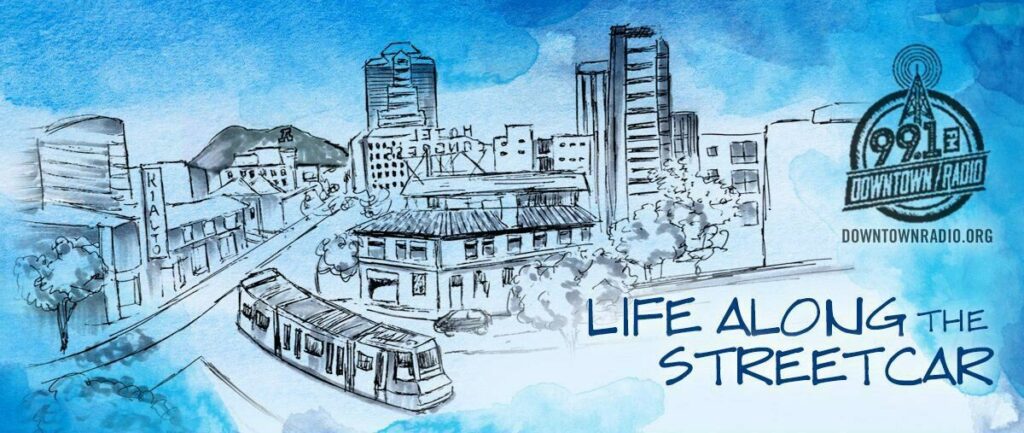Transcript
To Give is Better Than to Receive
Tom Heath: Good morning Tucson. It’s a beautiful sunny day in the Old Pueblo. Thank you for spending a part of your brunch hour with us on your downtown Tucson Community sponsored Rock n Roll radio station. This week, we discuss the importance of authenticity in our food and what that means for Tucson’s economy. Today is December 1st. My name is Tom Heath and you are listening to Life Along the Streetcar.
Tom Heath: Each and every Sunday, our focus is on social, cultural and economic impacts and Tucson’s Urban core. And we highlight hidden gems everyone should know about. From A Mountain to the U of A and all stops in between, you get the inside track right here on 99.1 FM streaming on Downtown Radio.org. Also available on your iPhone or Android using our very own app. Just head over to your Google Play or the I store there and get Downtown Radio Tucson. Take us wherever you want to go. If you want to reach us on the show directly, our email address is [email protected].
Tom Heath: You can also find us on Facebook and Twitter and if you want to check out past episodes, you can go to our new web page Life along the streetcar dot org and just about each of our previous. Is a hundred and eleven episodes are available there.
Tom Heath: We’re going to start today’s show with a gift-giving miracle. It started 49 years ago when Ramon Gonzalez took a hundred and twenty-five dollars from his pocket to Hope host a Christmas Eve party for the neighborhood children on the street as a retired sheet metal worker $125 for nine years ago was quite a sum of money, but nevertheless he put together this party held at his house on 31st Street in south Tucson.
Tom Heath: Well, 49 years later, the party has expanded it now takes a casino to hold it. It’s done at the Ava Amphitheatre and they expect about 10,000 kids. Well, Ramon Gonzalez started this endeavor from his home on 31st Street, and it’s become known as The Miracle on 34th Street, and if you want to support that, well the Regional Transportation authority (RTA) and Pima Association of governments (PAG) have their annual fill the streetcar with toys event.
Tom Heath: It’s coming up this Friday December 6th. It’s from 9 a.m. To 6 p.m. And we’ll be right there near the headquarters of the streetcar 360 eat East 88th Street. Well, of course link to that on our Facebook page, but you can head out there from 9:00 to 6:00 drop-off and wrapped toy and they will make sure it gets to the Miracle on 34th Street. And if it serves like anything in years past will be some music and entertainment throughout the day something you may want to check out this Friday the 6th.
Tom Heath: If you can’t make that, well, there are donations set up all throughout the urban core. There’s a places on Fourth Avenue, Main Gate, Downtown and even in the Mercado will put that link to all of those places on our Facebook here after the show. Well, last week we began in our interview with Jonathan Maybury and Janos Wilder, the Executive Director and the President, respectively, of the board for the nonprofit Tucson city of gastronomy.
Tom Heath: Last week’s episode, entitled Gastronomical Success is available on our webpage www.LifeAlongTheStreetcar.org if you want to listen to that one. Really good interview about what it took for Tucson to earn the first-ever UNESCO City of Gastronomy designation in the US. And technically, we were one of the First and North America because we got it the exact same day as Ensenada did, before that nothing in North America.
Tom Heath: But today’s focus is the second half of our interview in which we look at some impacts of that designation including the education for chefs, helping them understand our history, training them to be ambassadors to go out into the world and share Tucson’s unique food culture. And then the impact on our community, from the economic dollars created by food tourism and finally what we can expect from Tucson’s a culinary scene as we move forward. We’re going to pick up our conversation with Jonathan Mabry and Janos Wilder here with a question about authenticity.
Jonathan Mabry: I think that one of the things that Tucson chefs excel at, the chefs that we’re sending are using our heritage ingredients in Creative new dishes that they’re inventing? And they’re learning and I’m learning that that’s not the approach of all of the other cities of gastronomy. We’ve learned that most of the other cities of gastronomy. They’re emphasizing their traditional dishes and then in their approaches those dishes are their cultural traditions, and those dishes need to be made the same way with the same ingredients.
Jonathan Mabry: And then we have cities like Tucson and and San Antonio we have a lot of chefs who are we not only know how to make these traditional dishes of our region, but we have so much creativity among our chefs and they’re creating new dishes using our heritage ingredients and they’re doing that in San Antonio to and a few of the other cities with Gastronomy so it gets Two different concepts of authenticity.
Jonathan Mabry: So most of the cities of gastronomy authenticity means making the traditional dishes with the with the traditional ingredients with the traditional preparation techniques and the traditional recipes and in their cities like to sauna San Antonio and most are cylinder, Sweden and others where It’s incredible how creative the chefs are being with with the traditional ingredients. And and and that’s authentic to and UNESCO recognizes that explicitly as often is authenticity because it UNESCO defines.
Jonathan Mabry: Food Heritage is living Heritage and it’s constantly being recreated. It’s not fixed and unchanging and and then I just learned about another concept of authenticity among the cities of gastronomy. That several of the cities of gastronomy in East Asia. Their chefs are open to new ingredients. But them authenticity is using the traditional preparation techniques. So it’s just interesting to see how varied the the concepts of authenticity are.
Janos Wilder: So I think that’s a really interesting conversation to have so in this country and others that that should mention the wrong of the chef is become defined and I’d say the last 35 to 50 years as one it begins to break tradition and changes cuisine to become consistent with modern life. So for instance and in France, you have a Cuisine that’s comes a long history of Cuisine, but most and the most recent and not the most recent but recent Incarnation through crammin escoffier who codified the food and the style of cooking was long meals and lots of preservation techniques.
Janos Wilder: And didn’t have a lot of refrigeration and it was just and it was part of the aristocracy and the aristocracy. The only ones that can afford eat that way modern Cuisine has been democratized. And so everybody is electric can get in this country. We’re a wealthy country and a lot of people are able to eat. Well in the job of the chef is to modify recipes and create recipes that can be great. In everyday basis or on a note the same basis and constantly push the envelope a bit in my mind.
Janos Wilder: One of the things that I went through as a young Chef learning about about business really there were models, but for this learning on my own authenticity was very important to me and learning about the ingredients but not only the ingredients that techniques is well in So I would take and sort of Define what I call the cultural Colony. I culinary icons like a chile. Relleno and determine what is the ideal type of that. What is that in its most basic best form? Which went? How did what kind of chili do you use?
Janos Wilder: How do you prepare the chili so that so that so that they’re prepared properly that there they can maintain their Vitality of their color their thickness their flavor. Lots of technique driven things that was Personal role for me is I wanted to become true to what our heritage was but then expanded and use it as a Point of Departure and by being authentic with with with technique and with ingredients but change it up from there. So not be not having to conform to any preconceived notions.
Tom Heath: So how does how does one get to that that part of a chile Relleno? Is this they are you researching or you are you eating it? Different restaurants, are you how do you figure out what the essence of a chile relleno means?
Janos Wilder: it becomes an intellectual exercise first so intellectually, what is this dish? Is it are you going to define the chile? Relleno by what’s inside of it? Or you’re going to find it. Are you going to Define it by the Chilean the use of the Chilean I make make a different choice. I made the choice. I wanted to find it by the chili and how the chili is handle. That’s the first thing so the techniques to preserve the chili.
Janos Wilder: It was more of a response to the front of 20 acres I had and then okay, so is it battered or is it not if it’s battered? What kind of batteries are you going to use? How do you how do you how do you bat or something like that? If you want to use a batter and not hide the flavor then what are those feelings going to be and me at that point that the whole world is open to you at?
Tom Heath: so this is going to sound like a silly question especially as I’m asking this to the two of you but why is authenticity so important?
Jonathan Mabry: Every place has a different history than a different story to tell and so I believe that authenticity is a way for people to express the continuity of their story in that place.
Janos Wilder: From the chef’s perspective it’s really important to me because it feels right and important powerful to be connected to the entire Continuum of culinary history. Welcomes know our place in that and have respect for what came before while moving forward and that’s happened in almost all areas all areas of life. But that connectivity to the past is what grounds you and adds depth and meaning to your life.
Tom Heath: So even even a restaurant owner in Tucson for 30 plus years. Yeah, and it sounds like every day you’re still learning.
Janos Wilder: Yeah. Oh my goodness.
Tom Heath: So these are these newer chefs that that are coming up that you’re training as ambassadors. You’re probably learning things from them that
Janos Wilder: oh, you better believe it. That’s one of the most thrilling pieces about it here.
Jonathan Mabry: The last the most recent Chef that we sent to represent Tucson. We selected a food truck chef. And of course, this is the food truck that was voted the best food truck in Tucson the last two years in a row geronimo’s Revenge Moma drill and He taught us some new things didn’t he?
Janos Wilder: Yeah, well, he he he was really steep in the in the region. He’s part native American is part of Hispanic. He has a long Heritage and he and the thing was really interesting about him was he was able to really personalize a lot of the culture and traditional stories and mythology as well so you can drive a lot of historical. Into the ingredients the explanation of the ingredients which he was he was using and in some cases myths that I did it. I didn’t know he probably did a maybe didn’t and with those traditional ingredients he invented An entirely new dish. Yes. Yes. He did. Yeah, and when to take the China he did he need a noodle dish and you know kind of ballsy taken a noodle dish to China but it was a kind of noodle that they had never seen before. Yeah based on course.
Tom Heath: Got to love Janos talking about a ballsy move to take noodles to China will be back to the completion of our interview with Janos and Jonathan Mabry of the Tucson city of gastronomy in just a few seconds here, but I want to remind you first that you’re listening to Life Along the Streetcar on Downtown Radio 99.1 FM and available for streaming on DowntownRadio.org.
Tom Heath: Well, let’s get back to the final segment of our two-part series. With a Jonathan Mabry and Janos Wilder from the Tucson City of Gastronomy. If you’re just joining us earlier in this episode, we talked about authenticity and why it matters in food production and some creative things that are happening within Tucson’s chefs and culinary world and we’re going to finish up with conversations about economic impact in food tourism with these two very knowledgeable gentlemen.
Tom Heath: So here’s a good problem to have but with all this Talent a coming, can Tucson sustain this level. Do we have the population that that can can support this?
Jonathan Mabry: Sustain this creativity? Yeah. Absolutely.
Janos Wilder: Yeah, I would pivot that I would actually pivot there because it’s not just the base population, which is always an increasing but it’s the tourist population mean that that is that’s a big economic boost. So this is Big economic driver and the tourism that that become having this designation brings to us and that in the demands that they have or that spec I would better put as expectations. They bring is going to continue to push this in perpetuated for so the figure is that since we’ve got this designation there has been over 31 million dollars worth of Unpaid advertising is advertising or journalism on the city of astronomy. The research shows that that one of the two of the things that people are looking for when they travel Mount travels different Travelers are different than they were 20 and 30 years ago longer ago than that. It’s the word authenticity comes up again.
Janos Wilder: And there is culinary travel. People are traveling on their stomachs and they want new experience and experience that can only be had where they were where they’re traveling to so that really sort of that creates even more more demand.
Jonathan Mabry: And with all this media attention about our UNESCO Gastronomy designation more and more tourists are coming to Tucson for the food and visit Tucson. Told us recently that since the designation there’s been a 14% increase in the dollars spent by tourists in our restaurants and last year in 2018 visitors spent six hundred and ninety four million dollars in our restaurants.
Tom Heath: That’s a lot of chile rellenos. That’s what
Janos Wilder: We actually have a program that is designed to make it easier. Not only for tourists to find restaurants that are following the precepts. I supposed if you will of city of gastronomy and the foods of the region but both tours and for people who live here and we have just initiated a certification program. So that restaurants can be Five as Tucson City of Gastronomy, sort of certified restaurants and we’re just launching that right now. It’s this is this is is really kind of a big deal. I think locally and will be a big deal nationally and it would be a really big deal with in our Creative Cities Network because this is something that no other city is doing and we’re going to be leading the way and it had a great this is As well as our Ambassador program. Not many doing anything with like we’re doing in our basketball program either.
Tom Heath: It’s fantastic. So what’s next on the horizon? What’s I mean besides the the application process? What’s the big things coming up?
Jonathan Mabry: Well, we are working with the McGuire Center for entrepreneurship at the Eller College of Management at the University on developing a regional food brand for Southern Arizona. So that consumers can Recognize when they go into the stores. What are the what are the truly Local Foods of this region and not not foods that most of the ingredients are being imported and they’re just the products are just being packaged here. But know the ingredients the ingredients are from here and its unique food products that include Regional ingredients so we think that there’s a consumer interest in this and we know that there’s interest by visitors and I mean when you go to a city in another part of the world, aren’t you looking for? What are the food products that I can’t find anywhere else? I want to bring some of those home. That’s what everybody’s looking for. That’s exactly right. Yeah. We’re excited to get going on that project. And we’re still thinking it through we’re still studying these types of hyper local food brands and in other regions to learn from them and we’re going to do it here.
Janos Wilder: That that’s that’s a that’s going to be another sort of Game Changer because your…
Tom Heath: Tucson seems to be changing this game quite a bit.
Janos Wilder: Come back to us next fall. We’ll have a whole new mystery stuff for you. Yep. Well listeners can always keep up with what’s going on and learn more about the designation and about the what the nonprofit is doing by going to the website Tucson.CityOfGastronomy.org
Tom Heath: Once again, Jonathan Mabry, Executive Director Tucson City of Gastronomy, nonprofit organization and Janos Wilder, President of the board and Restaurant Owner of Downtown Kitchen + Cocktails and Carriage House, both right down here in the heart of Downtown. Two men that are extremely knowledgeable, I can’t think of two people that are probably more knowledgeable than those guys when it comes to our food history, our food culture and how it can be implemented in everyday life. So exciting to see how Tucson Is sort of taking the lead now, they’ve got this designation taking this lead and really kind of moving to Tucson to the Forefront of some of the creative ways to use this designation to make a difference within your community.
Tom Heath: Well, my name is Tom Heath and you are listening to Life Along the Streetcar on Downtown Radio 99.1 FM and available for streaming on DowntownRadio.org. That’s a wrap there for episode number 112 can’t believe we’re in the month of December that that amazes me but we are and we do have a good lineup for you coming up this month.
Tom Heath: We’ll do a little conversation with Sean Louis from Black Renaissance, got information about the Student Union in the historical and cultural significance of that fantastic building. We’ll talk a little bit of Lala Guerrero whose birthday is later this Month, and if all goes according to plan, we’ll wrap up December with some interesting talk about New Year’s Resolutions.
Tom Heath: If you want to check out today’s episode with Janos Wilder and Jonathan Mabry of Tucson City of Gastronomy, you can head over to our web page Life Along the Streetcar.org and you can also check out any of our past hundred eleven episodes almost all of them are up there a couple are missing but you’ll find most of them on there and then always stay in tune with Facebook. So you can keep track of what we’re doing.
Tom Heath: Well, we started the story the show off today with a story about Ramon Gonzalez, a retired sheet metal worker who pulled together a hundred twenty-five dollars 49 years ago and hosted a Christmas Eve party at his house for the neighborhood kids. Well now it is a big event with 10,000 kids expected at the casino. It’s called Miracle on 34th Street and you can fill the streetcar with that. All the details will be on our Facebook page when you fill the streetcar with toys. We’re leaving with a song from Marshmallow Overcoat and honor of of Roman Gonzalez. The song is titled Miracle. So on their Best Of Series, 2008 to 2018. My name is Tom Heath Have a great week into next Sunday for more Life Along the Streetcar.



